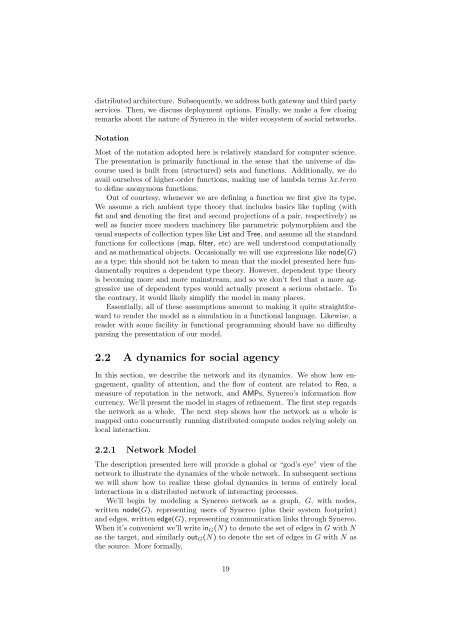Synereo Whitepaper With Cover
Create successful ePaper yourself
Turn your PDF publications into a flip-book with our unique Google optimized e-Paper software.
distributed architecture. Subsequently, we address both gateway and third party<br />
services. Then, we discuss deployment options. Finally, we make a few closing<br />
remarks about the nature of <strong>Synereo</strong> in the wider ecosystem of social networks.<br />
Notation<br />
Most of the notation adopted here is relatively standard for computer science.<br />
The presentation is primarily functional in the sense that the universe of discourse<br />
used is built from (structured) sets and functions. Additionally, we do<br />
avail ourselves of higher-order functions, making use of lambda terms λx.term<br />
to define anonymous functions.<br />
Out of courtesy, whenever we are defining a function we first give its type.<br />
We assume a rich ambient type theory that includes basics like tupling (with<br />
fst and snd denoting the first and second projections of a pair, respectively) as<br />
well as fancier more modern machinery like parametric polymorphism and the<br />
usual suspects of collection types like List and Tree, and assume all the standard<br />
functions for collections (map, filter, etc) are well understood computationally<br />
and as mathematical objects. Occasionally we will use expressions like node(G)<br />
as a type; this should not be taken to mean that the model presented here fundamentally<br />
requires a dependent type theory. However, dependent type theory<br />
is becoming more and more mainstream, and so we don’t feel that a more aggressive<br />
use of dependent types would actually present a serious obstacle. To<br />
the contrary, it would likely simplify the model in many places.<br />
Essentially, all of these assumptions amount to making it quite straightforward<br />
to render the model as a simulation in a functional language. Likewise, a<br />
reader with some facility in functional programming should have no difficulty<br />
parsing the presentation of our model.<br />
2.2 A dynamics for social agency<br />
In this section, we describe the network and its dynamics. We show how engagement,<br />
quality of attention, and the flow of content are related to Reo, a<br />
measure of reputation in the network, and AMPs, <strong>Synereo</strong>’s information flow<br />
currency. We’ll present the model in stages of refinement. The first step regards<br />
the network as a whole. The next step shows how the network as a whole is<br />
mapped onto concurrently running distributed compute nodes relying solely on<br />
local interaction.<br />
2.2.1 Network Model<br />
The description presented here will provide a global or “god’s eye” view of the<br />
network to illustrate the dynamics of the whole network. In subsequent sections<br />
we will show how to realize these global dynamics in terms of entirely local<br />
interactions in a distributed network of interacting processes.<br />
We’ll begin by modeling a <strong>Synereo</strong> network as a graph, G, with nodes,<br />
written node(G), representing users of <strong>Synereo</strong> (plus their system footprint)<br />
and edges, written edge(G), representing communication links through <strong>Synereo</strong>.<br />
When it’s convenient we’ll write in G (N) to denote the set of edges in G with N<br />
as the target, and similarly out G (N) to denote the set of edges in G with N as<br />
the source. More formally,<br />
19

















